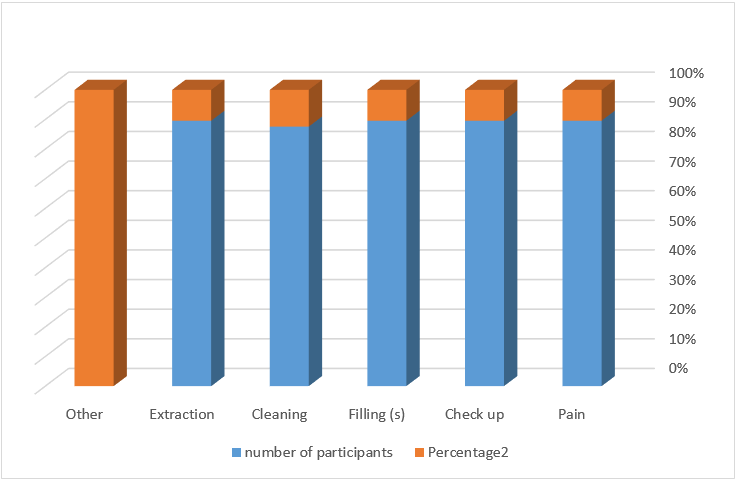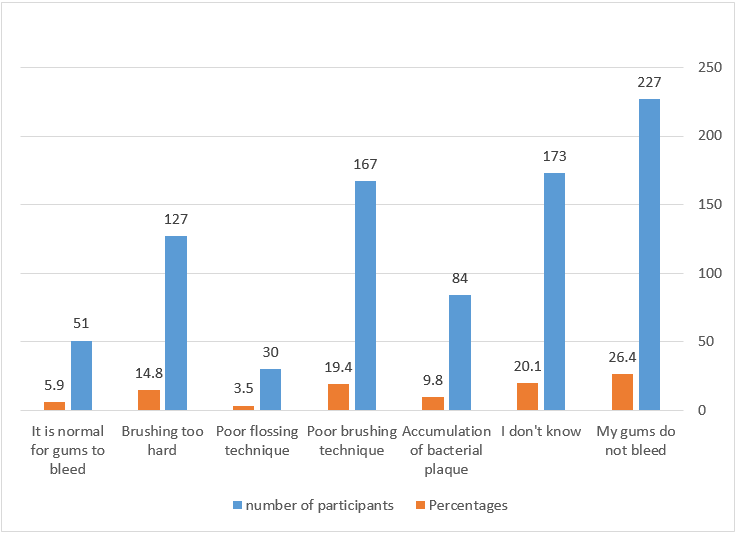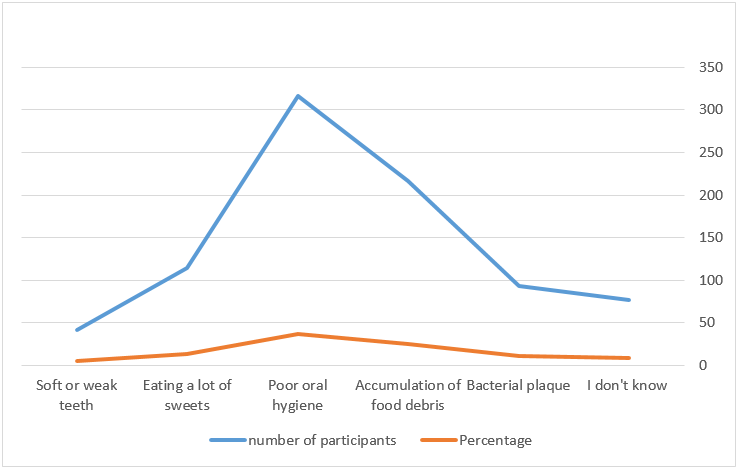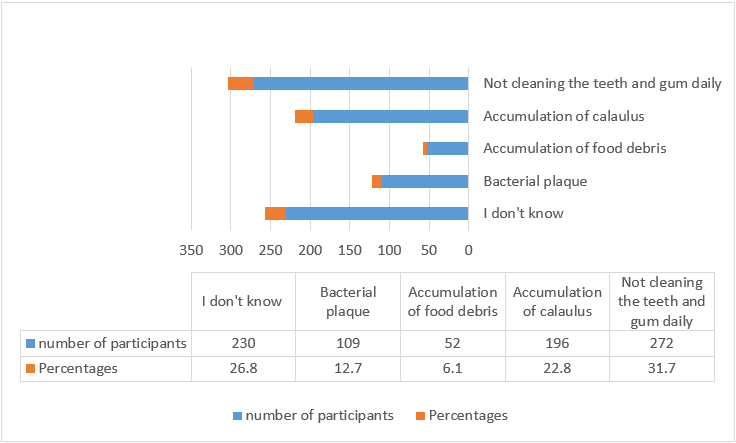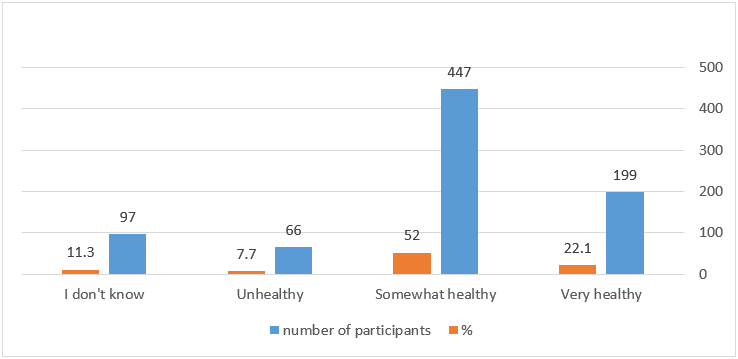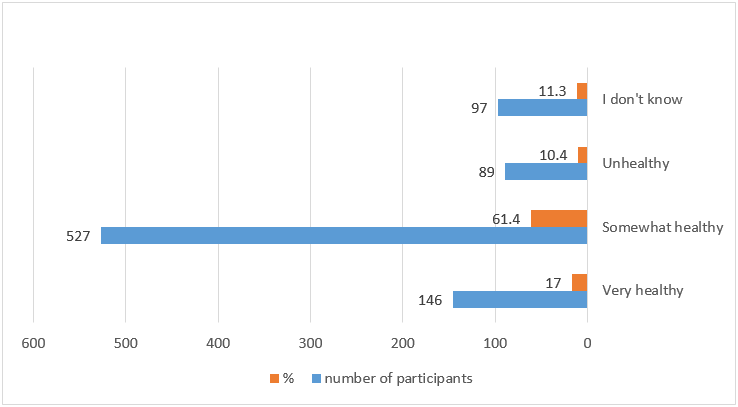Research Article
Volume 2 Issue 1 - 2020
Impact of Knowledge Level of Qatari People towards Oral Health
MSDH, Head of Oral Public Health Operations, Primary Health Care Corporation, Doha, Qatar
*Corresponding Author: Najat Abdrabbo Alyafei, MSDH, Head of Oral Public Health Operations, Primary Health Care Corporation, Doha, Qatar.
Received: March 03, 2020; Published: March 12, 2020
Abstract
Background: Oral care, hygiene and cleaning is influenced by the knowledge and perception of the Qatari people towards the importance of oral hygiene and cleaning. The choice of oral cleaning methods is also characterized by the level of dental knowledge of the people. This is first study on oral health knowledge of Qatari adult.
Objectives: To evaluate the knowledge of Qatari people towards oral health and oral hygiene.
Materials and Methods: The quantitative research study has been conducted on sample of Qatari population on the basis of the non-probability convenience sampling technique. A cross-sectional questionnaire study was conducted among 859 Qatari adults, aged between 18 and 72 years to evaluate their oral health knowledge. The data was analyzed using frequencies, percentages, Chi-square test and analysis of residual test.
Results: Of the study revealed that people with lower knowledge level prefer home remedies for oral cleaning, show lesser frequency of tooth brushing and avoid visits to dental appointments and clinics. Whereas people with higher knowledge level shows higher frequency of tooth brushing and regular visits to dental clinics for oral flossing and cleaning.
Conclusion: It can be concluded that people with higher dental knowledge level are more responsible and cautious and show positive oral health behavior. Therefore, it is recommended that increasing dental knowledge level of Qatari people can decrease the rate of periodontal diseases in Qatar.
Keywords: Oral health; Knowledge; Qatari Adults
Introduction
Oral hygiene and cleaning techniques refer to those methods by which oral cavity, teeth, and the gums are cleansed to prevent bacterial, tartar or plaque growth. The use of these cleaning techniques is important for everyone to prevent unwanted bacterial growth that decays tooth and gums of the people (Amin, Al?Omoush & Hattab, 2001). In 1994, 10,124 periodontal records of Qatari dental patients were assessed and found to have at least one of the following: gingivitis, periodontal disease, and periodontal or periapical abscesses (HMC- Dental Department-Personal Communication, September 1997). Even though the periodontal disease is a problem facing the Qatari population, only one dental hygienist was available to educate the whole population about preventive oral healthcare and 4 periodontists (HMC Dental Department-Personal Communication, September 1997). Presently in Qatar, 12 periodontists between Hamad Medical Corporation and Primary Health Corporation and 12 dental hygienists to cover a population of 2,864,402 based on Worldmeter (February, 2020), 313,000 from the total population are Qatari citizens (Wikipedia, 2017).
Since a large percentage of Qatari people have periodontal disease, they need to improve their knowledge to decrease the incidence of periodontal diseases.
It has been found that no research has been conducted regarding the knowledge level of Qatari people regarding the importance of oral hygiene and cleaning. This research deficiency discourages dental professionals from assessing and improving patients’ oral health knowledge and self-care behaviors. This research study is the first to measure the oral health knowledge, of Qatari people and provide a foundation for the development of effective oral health educational strategies to increase awareness in the Qatari people (Al-Darwish, 2016).
Research Question
What is the impact of the knowledge level of Qatari people on their oral hygiene and oral cleaning?
What is the impact of the knowledge level of Qatari people on their oral hygiene and oral cleaning?
Research Significance
This study is focused on the exploration of the knowledge level of the Qatari people regarding the importance of the dental hygiene and oral cleaning. The outcomes of this study will be utilized by the concerned authorities to increase the dental care knowledge among Qatari people through awareness campaigns, informative programs, and other educational strategies. The implementation of the knowledge increasing strategies will result in more responsible and careful attitude of the Qatari people and ultimately in a decreased rate of periodontal diseases in Qatar (Honkala, 2014).
This study is focused on the exploration of the knowledge level of the Qatari people regarding the importance of the dental hygiene and oral cleaning. The outcomes of this study will be utilized by the concerned authorities to increase the dental care knowledge among Qatari people through awareness campaigns, informative programs, and other educational strategies. The implementation of the knowledge increasing strategies will result in more responsible and careful attitude of the Qatari people and ultimately in a decreased rate of periodontal diseases in Qatar (Honkala, 2014).
Literature Review
Schwarz and Edward (1994) focused on adults in Hong Kong who have been shown, from studies by Lind et al (1987), Lee (1988), and Suo (1988) to have low levels of dental health knowledge. Two groups participated in the study: 35- 44-year-old adults (n = 398) and one group of 65-74-year-old adults (n=559). Interviews were conducted using the same questions for each group. Participants were asked to rate their knowledge of dental caries, periodontal disease, and preventive measures using a belief scale of 0 to 100. The results of all the questions were combined and divided, and an importance scale was designed with 1 meaning very important to 5 meaning, not at all important. An overall attitude score was obtained by combining the total belief score and importance score. Results suggested that misinformation about the causes of gum disease existed in both age groups. Twenty-seven percent of the younger group and 55% of the older group did not know what causes gum disease. Regarding preventive interventions to fight gum disease, 43% of the middle age group and 70% of the elderly group were not aware of preventive options. A positive correlation existed between dental knowledge, higher education levels, and regular dental visits in both groups. When asked if seeing a dentist was important, only 66% said yes. The highest attitude scores came from women, people who habitually seek dental care, and those who used preventive measures. Their study suggests that the adult Asian population needs oral hygiene education and that most (95%) want to have healthy teeth. This study has led to public awareness campaigns in Hong Kong aimed at bacterial plaque control and tooth brushing.
Schwarz and Edward (1994) focused on adults in Hong Kong who have been shown, from studies by Lind et al (1987), Lee (1988), and Suo (1988) to have low levels of dental health knowledge. Two groups participated in the study: 35- 44-year-old adults (n = 398) and one group of 65-74-year-old adults (n=559). Interviews were conducted using the same questions for each group. Participants were asked to rate their knowledge of dental caries, periodontal disease, and preventive measures using a belief scale of 0 to 100. The results of all the questions were combined and divided, and an importance scale was designed with 1 meaning very important to 5 meaning, not at all important. An overall attitude score was obtained by combining the total belief score and importance score. Results suggested that misinformation about the causes of gum disease existed in both age groups. Twenty-seven percent of the younger group and 55% of the older group did not know what causes gum disease. Regarding preventive interventions to fight gum disease, 43% of the middle age group and 70% of the elderly group were not aware of preventive options. A positive correlation existed between dental knowledge, higher education levels, and regular dental visits in both groups. When asked if seeing a dentist was important, only 66% said yes. The highest attitude scores came from women, people who habitually seek dental care, and those who used preventive measures. Their study suggests that the adult Asian population needs oral hygiene education and that most (95%) want to have healthy teeth. This study has led to public awareness campaigns in Hong Kong aimed at bacterial plaque control and tooth brushing.
It was noted that just 17% of a dentist’s time was devoted to prevention, and only 18% used a periodontal probe regularly. Seventy-five percent of the Irish public knew that gingival bleeding was a sign of an oral health problem, and 68% considered it part of a serious gum condition, much higher than predicted by dentists (Buckley, 1993). The survey showed that 55-70% of the Irish population had calculus and that gingivitis was on the rise in the general population. This is especially significant because only 66% of the surveyed participants see a dentist regularly (Buckley, 1993).
Rayant (1979) conducted a study in Britain to understand how dental health knowledge affects people who have relatively positive attitudes about oral hygiene. A total of 161 patients first filled out a survey to determine their dental health attitudes and knowledge. Thereafter, all subjects were examined to determine their individual plaque index (PI) and gingival index (GI) scores. The group was then divided into five segments, depending upon their GI scores. Gingival index scores in Rayant’s (1979) study ranged from 0.13 to 1.83. Twenty percent of subjects had scores less than 0.67, 40% of subjects were less than 0.85, 60% of subjects were below 1.00, and 80% of subjects were below 1.25. Plaque index score ranged from 0.17 to 1.71. Sixty percent of subjects had a score lower than 1.00. The survey revealed that 80% of the participants had a positive outlook on their dental health; 78% were concerned about losing their teeth, 99% were worried about how their teeth looked, and 78% were willing to invest time and money for the care of their teeth. The “difference” obtained from t-tests analyses were applied to find differences in attitudes and knowledge between those who did maintain gingival health (GI group 1< 0.7) and those who did not.
Dental knowledge also was assessed by An?eli?, Matijevi? & An?eli?, (2015). The study found that fifty percent of the subjects had recognized their own dental conditions, and just 10% were unaware that they needed treatment. Most patients (n=126) knew that bleeding gums were a sign of disease, 94 believed that they had swollen gums, and 70 patients thought loose teeth and recession were indicative of disease. One hundred nine patients knew that incorrect brushing could lead to gum disease, 91 patients acknowledged plaque, 77 patients said they knew about germs and bacteria. Halitosis and red gums were mentioned by 22 people, and only five patients did not know that they had halitosis. In terms of oral health behavior, toothbrushes were the most common cleaning tool used.
In another study, Tan (1979) measured the effectiveness of one session of dental health education, including a prophylaxis, on patients' dental attitudes, habits, and knowledge. Education is an effective strategy for controlling plaque and gingivitis, and Tan's study built upon this belief by assessing how dental health instructions affect patients' knowledge and attitudes about oral health technique. In all, 96% of two Dutch army camp residents were assigned to one of four groups: a control group (A); a group who had one oral prophylaxis (B); a group that received one session of dental health instruction (C); and a group that received both prophylaxis and instruction (D). Groups C and D received lecture which included information about dental caries and gingivitis. Both a dentist and hygienist participated in the lecture that was followed by a group discussion. At the end of 30 minutes, groups C and D received individualized instructions for 10 minutes from the hygienist. The prophylaxis provided to groups B and D included calculus removal, curettage, and polishing. The hygienist was careful not to give any information on the prophylaxis to those in group-B. All of the education and prophylaxes were done after the participants had completed a questionnaire on dental knowledge and attitudes toward oral hygiene.
Home care kits were given to everyone. One to three months after the study, the patients completed a questionnaire containing 10 items about dental knowledge, 12 concerning dental attitudes, and 7 concerning oral health behaviors. Chi-square analysis, multivariate analysis of variance, and univariate analysis of variance revealed no differences among the four groups. At the one and three-month examinations, significant differences were observed between groups. The difference between groups A and B were minimal, but groups C and D had significantly increased their knowledge. At one month, group C's knowledge score was 0.54 and increased to 0.56 at three months; group D's knowledge score was 0.42 and increased to 0.46 at three months. Regarding attitude, there were obvious differences between the groups at the baseline exam (p< .05). However, when comparing the baseline, one month, and three- month exams, no significant difference among the groups were found.
Methods
Research Study
Quantitative research design has been utilized in this study as it has not utilized statistical or numerical data regarding the knowledge level of the Qatari people. The quantitative design has enabled the researcher to devise well-connected data collection and data analysis techniques so that the oral hygiene knowledge level of the Qatari people could be investigated.
Quantitative research design has been utilized in this study as it has not utilized statistical or numerical data regarding the knowledge level of the Qatari people. The quantitative design has enabled the researcher to devise well-connected data collection and data analysis techniques so that the oral hygiene knowledge level of the Qatari people could be investigated.
Data Collection
Data collection technique that has been devised in this study based on a self-designed questionnaire on Qatari oral health knowledge distributed between Qataris in Doha. Since the Arabic language is the official language of the country, both the questionnaire and the letter of intent have been translated. The questionnaire consisted of two sections.
Data collection technique that has been devised in this study based on a self-designed questionnaire on Qatari oral health knowledge distributed between Qataris in Doha. Since the Arabic language is the official language of the country, both the questionnaire and the letter of intent have been translated. The questionnaire consisted of two sections.
- The demographics, age, gender, marital status, and the level of education of the respondents.
- The dental knowledge section discussed the knowledge of the participants towards oral health knowledge.
Ethical considerations
The ethical issues to consider and study participants, a questionnaire with a cover letter explaining the purpose of the study and explaining how the information provided by the participants will improve the health and quality of life in Qatar. The letter also informed the participants that the data will be kept confidential, and they said the participants were able to receive the results, submit their names and addresses to the main researcher and/or research assistants after the collected data.
The ethical issues to consider and study participants, a questionnaire with a cover letter explaining the purpose of the study and explaining how the information provided by the participants will improve the health and quality of life in Qatar. The letter also informed the participants that the data will be kept confidential, and they said the participants were able to receive the results, submit their names and addresses to the main researcher and/or research assistants after the collected data.
To give importance to the protection of human rights, presented to the Institutional Review Board at the University of Old Dominion a consent form to protect human beings, adopted on March 9, 1998. The consent was aimed to inform the Board that all participants they volunteered to answer the research questionnaire and was able to freely withdraw their participation at any stage of the study.
Survey instrument
The data collection tool was a self-administered, structured, anonymous questionnaire. It was used assess to the oral health knowledge of participants. The questionnaire consisted of two sections: Demographic characteristics and Oral health knowledge. The content validity of the questionnaire was established by a panel of dental experts at Old Dominion University. Since Arabic is the official language of Qatar, the covering letter, consent form and questionnaires were translated into Arabic.
The data collection tool was a self-administered, structured, anonymous questionnaire. It was used assess to the oral health knowledge of participants. The questionnaire consisted of two sections: Demographic characteristics and Oral health knowledge. The content validity of the questionnaire was established by a panel of dental experts at Old Dominion University. Since Arabic is the official language of Qatar, the covering letter, consent form and questionnaires were translated into Arabic.
Pilot study
Prior to the main study a pilot study was conducted on 20 Arab college students at University of Old Dominion. It was noted that the questionnaire could be completed in 10 minutes duration. The test-retest correlation value was 0.85 indicating acceptable reliability.
Prior to the main study a pilot study was conducted on 20 Arab college students at University of Old Dominion. It was noted that the questionnaire could be completed in 10 minutes duration. The test-retest correlation value was 0.85 indicating acceptable reliability.
Risks and Limitations
The study did not involve any risk. The results will be used to develop procedures to improve the attitudes and response of oral health professionals and instructions in Qatar. The limitations found in the study included the extension of results similar to those of the Qatar sample, and a population of age 18 years or less was not considered in this study.
The study did not involve any risk. The results will be used to develop procedures to improve the attitudes and response of oral health professionals and instructions in Qatar. The limitations found in the study included the extension of results similar to those of the Qatar sample, and a population of age 18 years or less was not considered in this study.
Statistical Analysis
The recorded data was compiled and entered in a spreadsheet computer program and then exported to data editor page of SPSS version 25 (SPSS Inc., Chicago, Illinois, USA). The data was analyzed using frequencies, percentages, and the analysis of residual test. The analysis of residuals procedure, which tests the discrepancies between the observed and expected values, was used to determine which values were larger than what might be expected by chance.
The recorded data was compiled and entered in a spreadsheet computer program and then exported to data editor page of SPSS version 25 (SPSS Inc., Chicago, Illinois, USA). The data was analyzed using frequencies, percentages, and the analysis of residual test. The analysis of residuals procedure, which tests the discrepancies between the observed and expected values, was used to determine which values were larger than what might be expected by chance.
Data Sampling
The population sampling of the data in the study consists of the nonprobability convenience sampling method (n =1000). The study was conducted at multiple centers: Hamad Medical Corporation (HMC)-Dental Center where patients receiving dental appointments, as well as public and private dental clinic were approached. The study also approached students of the University of Qatar and governmental schools, police and army officers and other civil servants. These participants were scheduled to be appointed to the public school for dental and/or dental hygiene, or because they are in other public places. This multicenter based cross-sectional study was conducted by distributing 20-25 questionnaires to the Qatari adults scheduled for their dental appointments during the working hours in these centers. The data collection was completed in a duration of 2 months.
The population sampling of the data in the study consists of the nonprobability convenience sampling method (n =1000). The study was conducted at multiple centers: Hamad Medical Corporation (HMC)-Dental Center where patients receiving dental appointments, as well as public and private dental clinic were approached. The study also approached students of the University of Qatar and governmental schools, police and army officers and other civil servants. These participants were scheduled to be appointed to the public school for dental and/or dental hygiene, or because they are in other public places. This multicenter based cross-sectional study was conducted by distributing 20-25 questionnaires to the Qatari adults scheduled for their dental appointments during the working hours in these centers. The data collection was completed in a duration of 2 months.
To be included, the subjects must be aged between 18 and 72 and the participants are not limited to health or dental history. Participation is voluntary and not mandatory. The final sample was n = 859, 41% for men and 58.3% for women. About 41% were aged between 18 and 25, between 26 and 32, 30.5%, and 14.9% between the ages of 33 and 40; 7.7% between 41-48; 49-56 between the proportion is 3.3%, 1.2% is between 57-64 and 1.0%, between 56-72. Most of the respondents have university studies (49.2%), followed by high school graduates (29.6%), primary school graduates (10.8%), and individual education graduates (5.4%), and received staff (5.0%) of formal education.
Results
Demographic characteristics of the participants are presented in Table1. Regarding highest level of education attained, 5% of the respondents reported no formal education, 10.8% reported elementary school, 29.6% reported high school diploma, 49.2% were baccalaureate graduates and 5.4% of the respondents had graduate degrees.
| Number | Percentage (%) | ||
| Age | 18-25 | 356 | 41.4 |
| 26-32 | 262 | 30.5 | |
| 33-40 | 128 | 14.9 | |
| 41-48 | 66 | 7.7 | |
| 49-56 | 28 | 3.3 | |
| 57-64 | 10 | 1.2 | |
| 65-72 | 9 | 1.0 | |
| Gender | Male | 358 | 41.7 |
| Female | 501 | 58.3 | |
| Education level | No formal education | 43 | 5.0 |
| Elementary school | 93 | 10.8 | |
| High school | 254 | 29.6 | |
| Baccalaureate | 423 | 49.2 | |
| Graduate degree | 46 | 5.4 |
Table 1: Demographic characteristics of the study population.
The findings of the study showed the knowledge of the subjects indicated the primary reasons for tooth loss. Responses revealed that 8.5% (n=73) of the respondents felt aging was the primary reason for people with tooth loss; 5.6% (n=48) of the respondents said accident/injury was the primary reason; the majority 64.3% (n=552) indicated tooth decay; and 21.7% (n=l 86) reported gum diseases (Table 2).
| Accidental decay | Gum diseases | Aging | ||||||||
| n | % | R | n | % | R | n | % | R | ||
| Age | 18-25 | 59 | 16.6 | -21.0 | 186 | 52.2 | 10.7 | 111 | 31.2 | 10.3 |
| 26-32 | 63 | 24.0 | 4.1 | 139 | 53.1 | 10.0 | 60 | 22.9 | -14.1 | |
| 33-40 | 44 | 34.4 | 15.2 | 58 | 45.3 | -5.0 | 26 | 20.3 | -10.2 | |
| 41-48 | 14 | 21.2 | -.8 | 28 | 42.4 | -4.5 | 24 | 36.4 | 53 | |
| 49-56 | 9 | 32.1 | 2.7 | 8 | 28.6 | -5.8 | 11 | 39.3 | 3.1 | |
| 57-64 | 3 | 30.0 | 0.8 | 3 | 30.0 | -1.9 | 4 | 40.0 | 1.2 | |
| 65-72 | 1 | 11.1 | -1.0 | 1 | 11.1 | -3.4 | 7 | 77.8 | 4.5 | |
| Education level | No formal education | 5 | 11.6 | 4.7 | 9 | 20.9 | -12.2 | 29 | 67.4 | 16.8 |
| Elementary school | 25 | 26.9 | 4.1 | 39 | 41.9 | -6.8 | 29 | 31.2 | 2.7 | |
| High school | 47 | 18.5 | -10.1 | 120 | 47.2 | -5.1 | 87 | 34.3 | 15.1 | |
| Baccalaureate | 108 | 25.5 | 13.0 | 228 | 53.9 | 19.7 | 87 | 20.6 | -32.7 | |
| Graduate degree | 8 | 17.4 | -2.3 | 27 | 58.7 | 43 | 11 | 23.9 | -2.0 | |
R= Residual analysis test
Table 2: The importance of oral & dental knowledge cross-tabulated with their age and level of education of the Qatari people sample (n = 859).
Table 2: The importance of oral & dental knowledge cross-tabulated with their age and level of education of the Qatari people sample (n = 859).
On the question of the primary reason for coming to the dental clinic, of the respondents, 50.3% (n=432) came to a dental clinic when experiencing pain; 17.5% (n=150) came for checkups; 12.1% (n=104) came for fillings; 2.8% (n=24) came for tooth extraction; 17.3% (n=122) came for cleaning, and 3.1% (n=27) had other reasons (Figure 1).
In further items, subjects were asked to indicate when they cleaned their teeth: after waking up, after eating breakfast, after eating dinner, before going out, before going to bed, prior to special occasions, e.g., parties and holidays. Findings from item 14 revealed that 74% (n=641) of the respondents cleaned their teeth after waking up; 18.4% (n=158)
Another item asked about the technique used by Qatari people when brushing their teeth. Responses revealed that 52.3% (n=449) of the respondents use their own technique; 27.9% (n=240) use a technique taught to them at a dental clinic; 16.4% (n=141) use no special technique; 3.4% (n=29) use other techniques.
In further items of the questionnaire, subjects were asked to indicate why they thought their gums bled. Findings revealed that 26.4% (n=227) of the respondents do not have bleeding gums; 20.1% (n=173) did not know the reason for their bleeding gums; 9.8% (n=84) implicated bacterial plaque; 19.4% (n=167) answered poor brushing technique; 3.5% (n=30) implicated poor flossing technique as the culprit for bleeding gums; 14.8% (n=127) answered brushing too hard; and 5.9% (n=51) believed that bleeding gums were normal (Figure 2).
Another item requested subjects to indicate how often their gums bled. Responses revealed that 5.7% (n=49) of the respondents experienced bleeding gums frequently; 30.8% (n=265) have gums that bleed sometimes; 35.2% (n=302) said that their gums seldom bleed, and 7.9% (n=68) did not know the reason for their bleeding gums. The other 19.8% (n=175) subjects indicated that their gums did not bleed (Figure 3).
On an item asking of the primary etiology for dental caries and periodontal disease? Respondents of 9.0% (n=77) did not know the primary cause of tooth decay; 10.8% (n=93) answered bacterial plaque; 25.3% (n=217) answered accumulation of food debris; 36.9% (n=317) answered poor oral hygiene; 13.3% (n=114) answered eating a lot of sweet; and 4.7% (n=41) answered soft or weak teeth were the cause of tooth decay (Figure 4).
On the item required to identify the primary cause of periodontal disease. Of the respondents, 26.8% (n=230) did not know the primary cause of the periodontal disease; 12.7% (n=109) implicated dental bacterial plaque; 6.1% (n=52) answered accumulation of food debris; 22.8% (n=196) accumulation of calculus; and 31.7% (n=272) believed that not cleaning teeth and gums daily was the primary cause for periodontal disease (Figure 5).
Subjects requested to rate the health of their gums and teeth using: very healthy, somewhat healthy, unhealthy, and I do not know. Of respondents 22.1% (n=190) rated their gums as very healthy; the majority 52.0% (n=447) rated their gums as sometimes healthy; 7.7% (n=66) rated their gums as unhealthy; and 18.2% (n=156) of the respondents did not know (Figure 6). In terms of teeth, the results revealed that 17.0% (n=146) rated their teeth very healthy; the majority 61.4% (n=527) rated their teeth as sometimes healthy; 10.4% (n=89) rated their teeth as unhealthy; and 11.3% (n=97) of the respondents did not know (Figure 7).
Discussion
Interpretation of the study results revealed that majority of the knowledge of the Qatari people regarding the primary reasons for tooth loss. Responses revealed that elderly and participants with no formal education thought that aging was the primary reason for people to tooth loss; whereas few people perceive that accident/injury was the primary reason; the majority of educated participants indicated gum diseases to be the primary reason of tooth decay.
The reason of the bleeding gums was found to be the poor or vigorous brushing whereas other reason can also cause tooth bleeding which includes poor flossing, the implication of bacterial plaque and swollen gums. However, An?eli?, Matijevi? & An?eli?, (2015) also suggested that inappropriate tooth brushing and poor flossing are the primary reasons for the gum bleeding.
Inappropriate tooth brushing is also identified to be dependent on the knowledge level of the people living in Qatar. According to the knowledge level, the frequency of tooth brushing varied among the Qatari people as it has been observed that people, who realize the importance of oral hygiene and cleaning, brush more frequently and with greater quality. However, oral hygiene technique also differs according to the knowledge level as people with lesser oral hygiene level prefer home cleaning methods as compared to the use of mouthwash or having an appointment for an oral cleaning.
Conclusion
Most Qatari people view tooth decay as the primary cause of tooth loss while others implicated gum disease and aging as possible reasons for tooth loss. A minority identified accident/injury as the primary reason for tooth loss. Qatari people still viewed pain as the primary reason for seeking dental care. Few people perceive that they came to the dental clinic for restorative care, and very few come for regular checkups.
It has been found that very few Qatari people did not know the primary cause of tooth decay, while some can identify bacterial plaque, accumulation of food debris, poor oral hygiene, and soft or weak teeth as the cause of tooth decay. When Qatari people were asked about the primary cause of periodontal disease, few people did not know the reason, whereas some believed that accumulation of bacterial plaque led to periodontal disease, while majority identified the accumulation of food debris, accumulation of calculus, and failure to clean gums and teeth daily as the reason for the development of periodontal disease. However, all the perceptions of the people were found to be greatly dependent on the knowledge level of the Qatari people regarding the importance of the oral hygiene and cleaning.
Qatari people’s dental knowledge could benefit from more education and experience with contemporary oral health concepts and other preventive dental care interventions. Therefore, there is greater need to revise the dental health strategies so that educational strategies and awareness programs can be implicated in the region that can increase the knowledge and awareness of the people so that they can care of their oral cavity and prevent periodontal diseases.
References
- Al-Darwish, M. S., Abuhassna, M., & Al-Thomairy, S. A. (2015). Oral Health Knowledge and Sources of Oral Health Information among School Children in Qatar. Journal of Dental Health, Oral Disorders & Therapy, 2.
- Al-Darwish, M., El Ansari, W., & Bener, A. (2014). Prevalence of dental caries among 12–14 year old children in Qatar. The Saudi dental journal, 26(3), 115-125.
- Al-Darwish, M.S., (2016). Oral health knowledge, behaviour and practices among school children in Qatar. Dental research journal, 13(4), p.342.
- Al-Salahi, N. A. J. S. (1998). Oral health knowledge, attitudes, and behaviours of Qatari people.
- Amin, T. T., & Al?Abad, B. M. (2008). Oral hygiene practices, dental knowledge, dietary habits and their relation to caries among male primary school children in Al Hassa, Saudi Arabia. International journal of dental hygiene, 6(4), 361-370.
- Amin, W. M., AL?Omoush, S. A., & Hattab, F. N. (2001). Oral health status of workers exposed to acid fumes in phosphate and battery industries in Jordan. International dental journal, 51(3), 169-174.
- An?eli?, I., Matijevi?, S., & An?eli?, J. (2015). The importance of oral health behaviour of children for their oral health. Sanamed, 10(2), 101-107.
- Cheema, S., Maisonneuve, P., Al?Thani, M.H., Al?Thani, A.A.M., Abraham, A., Al?Mannai, G.A., Al?Emadi, A.A., Al?Chetachi, W.F., Almalki, B.A., Khalifa, H. and Ali, S.E., 2017. Oral health behaviour and factors associated with poor oral status in Qatar: results from a national health survey. Journal of public health dentistry, 77(4), pp.308-316.
- Honkala, E. (2014). Primary oral health care. Medical Principles and Practice, 23(Suppl. 1), 17-23.
- Musaiger, A. O., Al-Mannai, M., & Abduljawad, E. (2014). Association of oral hygiene habits and food intake with the risk of dental caries among undergraduate university women in Saudi Arabia. International journal of adolescent medicine and health, 26(4), 585-589.
- Silversin, J., & Kornacki, M. J. (1984). Acceptance of preventive measures by individuals, institutions and communities. International dental journal, 34(3), 170-176.
- Widiati, S., Santosa, A. S., Prabandari, Y. S., & Prawitasari, J. E. (2016). Oral health status of elementary-school children varied according to school they attended. Dental Journal (Majalah Kedokteran Gigi), 49(3), 163-167.
- Worldometer elaboration of the latest United Nations data (Feburary, 2020).
- Wikipedia (2017). The population of Qatari citizen.
Citation: Najat Abdrabbo Alyafei. (2020). Impact of Knowledge Level of Qatari People towards Oral Health. Journal of Oral Care and Dentistry 2(1). DOI: 10.5281/zenodo.3722840
Copyright: © 2020 Najat Abdrabbo Alyafei. This is an open-access article distributed under the terms of the Creative Commons Attribution License, which permits unrestricted use, distribution, and reproduction in any medium, provided the original author and source are credited.

